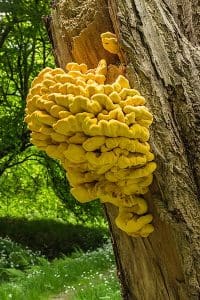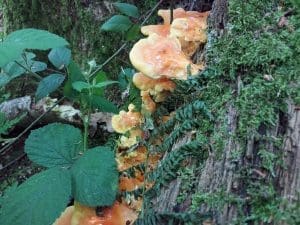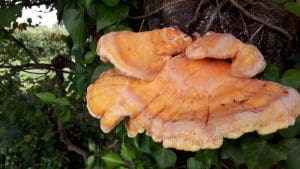Chicken Of The Woods / Summer / Autumn / Edible

Welcome to the fascinating world of the Chicken of the Woods mushroom, a highly sought-after and delectable edible fungus that has captivated foragers and mycophiles alike. This striking mushroom is known for its vibrant colouration and unique texture, which has earned it a place among the most popular and recognisable wild mushrooms.
Scientific Name
Laetiporus sulphureus
Common Names
Chicken of the woods, sulphur polypore, giant canary fan
Family
Fomitopsidaceae
Habitat
Nearly always found growing in association with hardwood, specifically oak, although it also grows on cherry, beech and other hardwoods. It has been found growing on Yew from time to time and it’s advised to avoid eating this mushroom if it’s growing on Yew (due to the potential for it to accumulate toxins from the yew wood)
Found all over Europe, UK, northern America and Northern Asia, although variations of this fungi can be found throughout the globe.
Description
Chicken of the woods typically grows on decaying trees (although the signs of decay aren’t always evident) and can be found growing quite high up the tree.
It grows off the wood like a shelf.
Identifying Features:
Upper surface:
The bright orange fruit body becomes paler towards its edges, up to 40cm+ across and is irregularly semi-circular, it comprises a number of thick overlapping brackets sprouting from one joined spot, it’s rather shaggy and velvety.
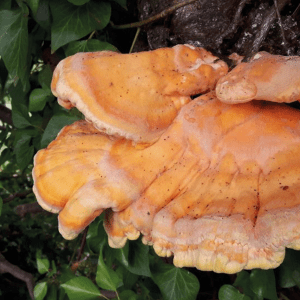
Underside:
The underside is yellow with circular or oval pores.
On breaking this fungus it appears to have the texture and consistency and look of chicken, when young it will ooze liquid on squeezing and when old it will crumble.
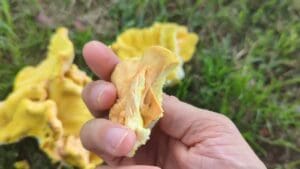
Foraging Chicken of the Woods Mushrooms Video
Known Hazards
People react to this fungi differently, it’s said that 1 in 10 people have adverse reactions to this fungus, usually just an upset stomach, but if vast amounts are eaten by this minority it can develop into vomiting and hallucinations have been recorded in the past. If you’re happy eating mushrooms normally you should be fine but it’s worth trying a little to start with before moving on to eating large amounts of this.
Potential lookalikes
Dyer’s maze gill (Phalous Schweinitzii), which surface is a lot rougher, chicken of the woods has a velvet surface and typically grows higher up on oak trees.
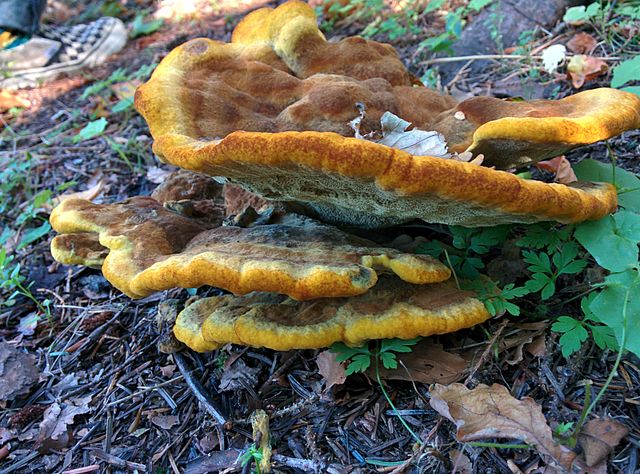
Giant Polypore (Meripilus Giganteus), this fungus is typically found at the base of trees whereas chicken of the woods is found higher up trees, giant polypore also discolours black on contact which chicken of the woods doesn’t.
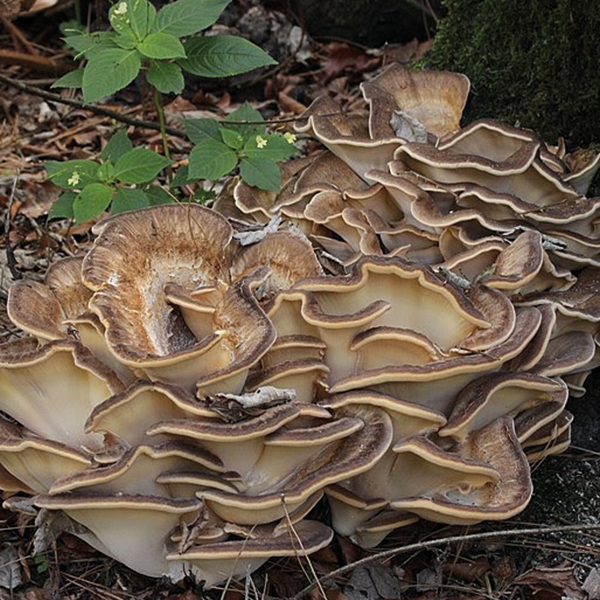
Uses:
In food
Young: Pies, Fried with bacon, as a substitute to chicken, to make vegan roast dinner, barbequed roasted, stuffed
Old: dried and powdered for flavourings and stocks, in a pate
Herbal
This fungus is a natural antibiotic and a weak disinfectant, as a whole it’s good at regulating health within the human body, improving and defending our bodies against illness. This may be down to Eburicoic acid produced by the sporophore which may be used to synthesize the steroids that play an important role in human health.
Extra notes from the foragers
It’s noted that old dry specimens of this fungi can be burnt to drive off mosquitoes, I tried this on a fire in our woods and it produced a lot of smoke but seemed to work.
A light yellow dye can be extracted from this fungus, with no mordant needed, this yellow takes well on chalk into a dried pigment.
I always had the idea that this fungus would make a good paper, but surprisingly it makes an incredibly weak paper. So you can make paper with it, but don’t expect it to last very long or have many applications.
Latiporus is derived from the Latin words Laet, meaning bright or pleasing and Por meaning pores. Sulphureus relates to the bright sulphur colour. Translating to bright and pleasing pores of a sulphur colour.
When this fungus grows high up in the trees I find it easiest to knock it off by holding a large stick and prodding around the fungi’s base until it drops and smashes in a great bloom of chicken of the woods.
If you have this fungus in vast amounts and don’t manage to eat it all or give enough away before it dries out, do not fret, you can also powder the dried mushroom and use it along with flour in baking bread, it can also be used with salt and pepper as a seasoning.



